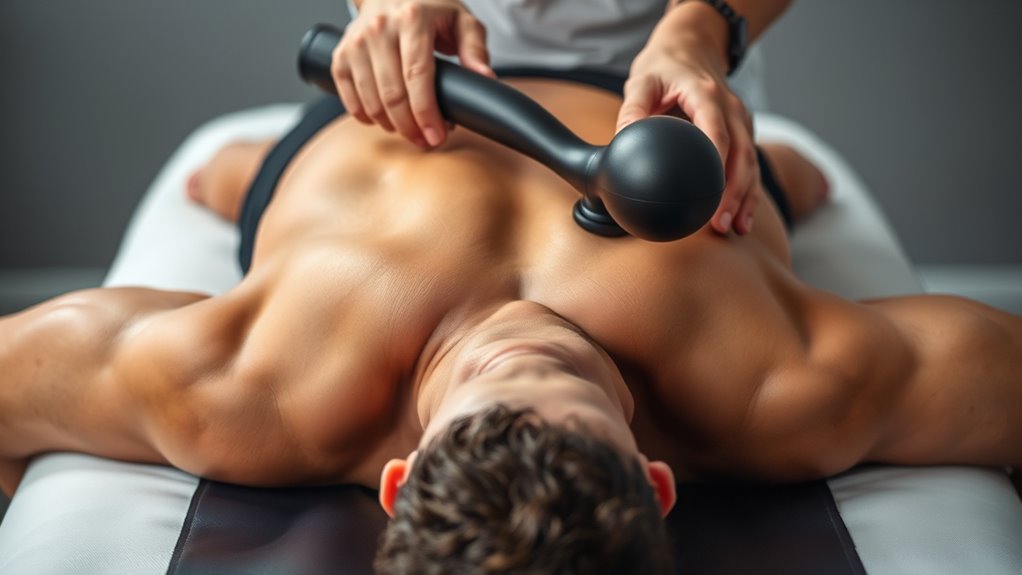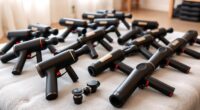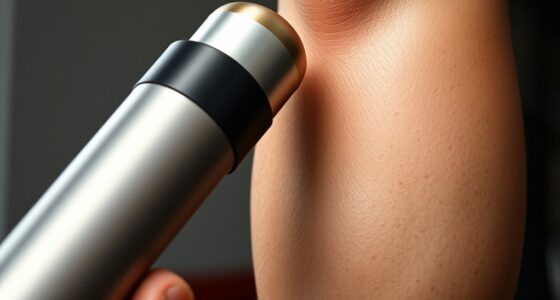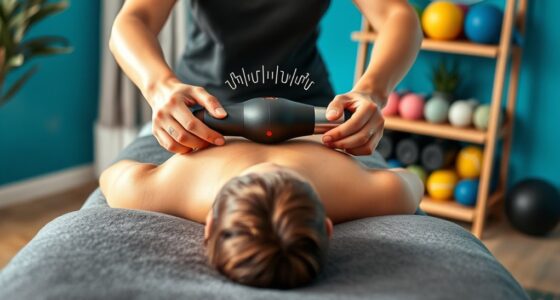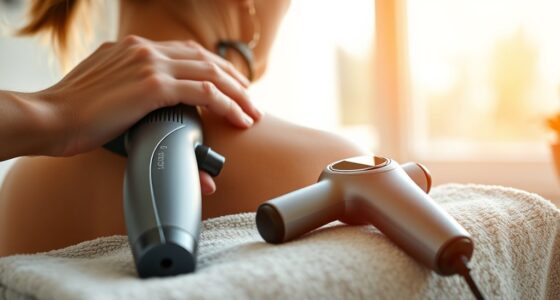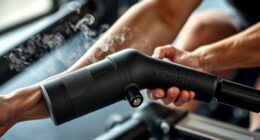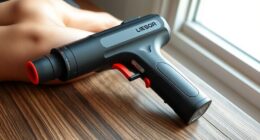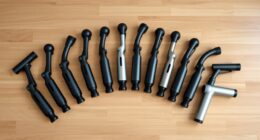Using percussion massage before your workout can seriously boost your warm-up. It helps increase blood flow, loosen tight muscles, and prepare your body for exercise. By targeting specific muscle groups, percussion devices can improve flexibility and reduce injury risk. This active approach primes your muscles at a cellular level, making your workout smoother and more effective. Keep exploring to discover how incorporating percussion massage into your routine can take your performance to the next level.
Key Takeaways
- Percussion massage increases blood flow and muscle temperature, enhancing muscle readiness for exercise.
- It helps loosen tight muscles and reduce stiffness, improving flexibility before workouts.
- Percussion devices target specific muscle groups, promoting deeper circulation and oxygen delivery.
- Regular pre-workout percussion massage can reduce injury risk by preparing muscles and breaking down adhesions.
- Incorporating percussion into warm-up routines supports better neuromuscular coordination and exercise performance.
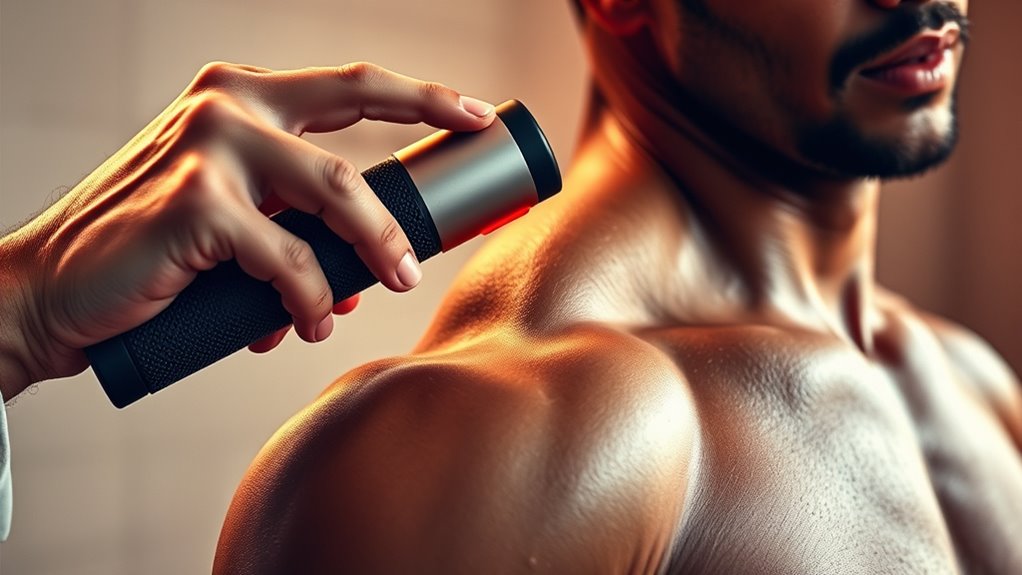
A pre-workout massage can considerably enhance your exercise performance by preparing your muscles and reducing the risk of injury. When you incorporate massage into your warm-up routine, you’re actively engaging in recovery techniques that prime your muscles for activity. This method helps increase blood flow, loosen tight muscles, and improve flexibility, all of which contribute to better performance and fewer setbacks during your workout. Using percussion massage devices or manual techniques can target specific muscle groups, releasing tension and reducing stiffness before you start moving. This proactive approach not only boosts your readiness but also minimizes the chance of strains or pulls that often occur when muscles are cold or unprepared.
By integrating a pre-workout massage into your routine, you’re focusing on injury prevention right from the start. Tight or overused muscles are more susceptible to tears and strains, especially during high-intensity exercises. A quick massage session helps break down adhesions and loosen knots that might otherwise lead to injury. Percussion therapy, in particular, delivers rapid, targeted pulses that penetrate deep into muscle tissue, promoting circulation and oxygen delivery. This process ensures your muscles are well-primed for the demands of your workout, reducing the likelihood of acute injuries and muscle soreness afterward.
Pre-workout massage reduces injury risk by loosening knots and promoting circulation.
Moreover, this type of massage can improve your overall warm-up efficiency. Instead of just stretching or doing light cardio, a pre-workout massage actively prepares your muscles on a cellular level. It encourages better neuromuscular coordination, so your body responds more effectively to movement and exercise demands. This means you can start your workout with more confidence, knowing your muscles are ready to perform at their best. Additionally, by incorporating massage into your warm-up, you’re adopting a holistic approach to training that emphasizes injury prevention and ideal recovery techniques. Preventing injuries isn’t just about avoiding setbacks; it’s about maintaining consistent progress and longevity in your fitness journey.
Engaging in a Glycolic Acid Exfoliating Toner routine regularly can further support your skin’s health, especially when combined with proper warm-up and recovery practices. In essence, a pre-workout massage isn’t just a luxurious add-on; it’s a strategic step to enhance your performance and safeguard your body. Whether you choose percussion devices or manual techniques, the goal remains the same: prepare your muscles efficiently, improve circulation, and reduce the risk of injury. When you consistently include massage in your pre-exercise routine, you’re investing in safer, more effective workouts that help you recover faster and stay injury-free over the long term.
Frequently Asked Questions
How Often Should I Get a Pre-Workout Percussion Massage?
You might wonder how often you should get a percussion massage before workouts. While there’s no one-size-fits-all, following general frequency guidelines helps you avoid overdoing it. Usually, 1-3 sessions per week work well, but personalized routines are key—listen to your body and adjust accordingly. Incorporating percussion massage into your warm-up can enhance performance, but guarantee you balance it with other pre-workout activities for maximum results.
Are Percussion Massages Suitable for All Fitness Levels?
Did you know that percussion massages are suitable for over 80% of fitness enthusiasts? You’ll find that massage adaptability varies, but percussion tools are generally accessible and easy to use. Whether you’re a beginner or an advanced athlete, these massages can boost your warm-up, improve circulation, and reduce muscle tension. Just make certain you choose equipment that fits your needs and consult a professional if you have any health concerns.
Can Percussion Therapy Replace Traditional Warm-Up Routines?
You might wonder if percussion therapy can replace traditional warm-up routines. While massage benefits like increased blood flow and muscle relaxation are helpful, they shouldn’t fully replace warm-up alternatives. Percussion therapy can complement your warm-up, easing muscle tension, but it doesn’t prepare your body as thoroughly as dynamic stretching or light cardio. Rely on a combination of methods for a safer, more effective workout.
What Are the Potential Risks of Using Percussion Devices Before Exercise?
Like Icarus flying too close to the sun, using percussion devices before exercise can pose risks. You might experience increased muscle soreness or injury risk if applied incorrectly or too aggressively. While percussion therapy can help with muscle relaxation, overdoing it may lead to tissue damage or exacerbate existing issues. Always use proper technique and consult a professional to minimize these potential hazards and protect your performance.
How Long Does the Benefit of a Percussion Massage Last During Workout?
The benefits of a percussion massage during your workout typically last around 30 minutes. It can enhance muscle recovery and help prevent injury by increasing blood flow and reducing muscle tension. As you move through your workout, you might notice improved flexibility and decreased soreness. To maximize these benefits, consider timing your percussion massage strategically, especially before intense activity, to support muscle readiness and injury prevention throughout your session.
Conclusion
So, next time you hit the gym, consider a pre-workout massage to prepare your muscles, improve your circulation, and boost your performance. A massage can relax your muscles, reduce your tension, and enhance your warm-up. It’s simple, effective, and worth trying. Remember, a good warm-up isn’t just about movement—it’s about mindful preparation. Embrace the massage, energize your body, and elevate your workout experience. Your muscles will thank you.
